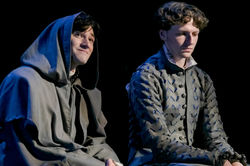MEASURE FOR MEASURE
By William Shakespeare
A version by Josie Rourke
Baldwin Wallace University
Spring 2024
Directed by: Laura Berg
Costume Design : Tesia Benson
Scenic Design: Jeff Herrman
Lighting Design: Maya Michele Fein
Photography: Daren Stahl
 Act 1: year 1604 |  Act 1: year 1604 |  Act 1: year 1604 |
|---|---|---|
 Act 1: year 1604 |  Act 1: year 1604 |  Act 1: year 1604 |
 Act 1: year 1604 |  Act 1: year 1604 |  Act 2: year 2025 |
 Act 1: year 1604 |  Act 1: year 1604 |  Act 1: year 1604 |
 Act 2: year 2025 |  Act 2: year 2025 |  Act 2: year 2025 |
William Shakespeare's "Measure for Measure" is widely considered to be a "dark" comedy. It follows a young Novemberitiate in Vienna, whose brother is the victim of an unexpected crackdown on an old and largely ignored law. As she attempts to beg for his life, she discovers a judicial system that has more to do with vengeance than justice. The play examines sexual politics through a particularly gendered lens and asks: When faced with corruption of power, how do we fix broken systems?
A Note on the Text from the adaptor:
This version of Measure for Measure is cut down from the original and fashioned into two parts of equal length, each of five acts. They are almost identical, except for one significant change: the gender of the novice and the deputy reverses in each version. In many respects, Part One plays as first published. The original plot of a male deputy (Angelo) propositioning the female novice (Isabella) in an exchange for her brother’s life is unchanged. In Part Two, the genders of deputy and novice reverse. The deputy is played by the female actor who was the novice, and the novice is played by the male actor who was the deputy. In both Parts One and Two, they retain the names ‘Angelo’ and ‘Isabella’. Although I have not modernized either part of the text, it is
imagined that Part One plays in the year it is believed to have been written, 1604, and Part Two plays in the present
